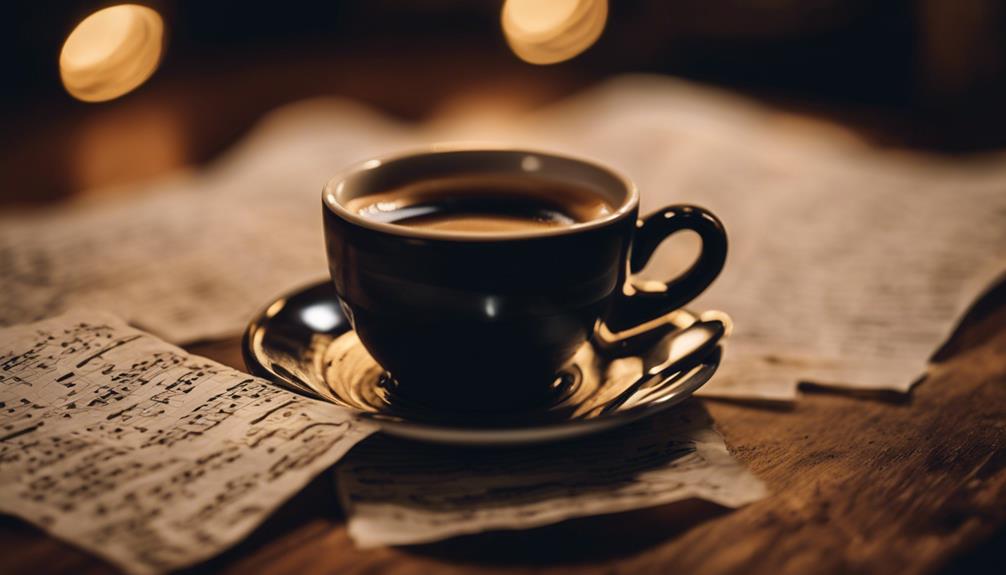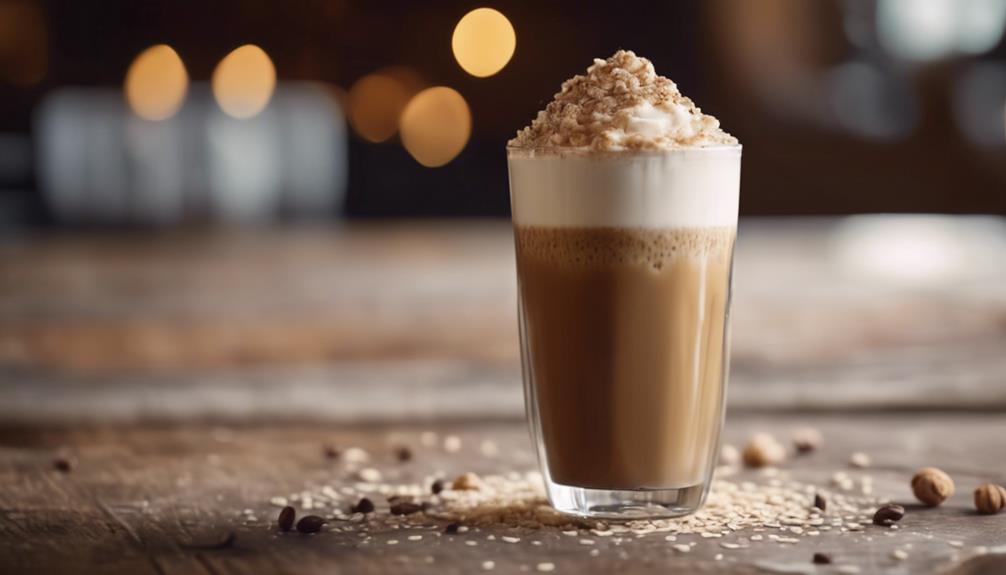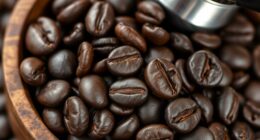To effectively determine the pricing for additional shots of espresso, take into account the cost of espresso beans, labor, and profit margins. Conduct an analysis of competitors to strategically set prices that align with your base strategy and cater to demand. Stand out by offering unique value and competitive pricing. Ensure that prices are set wisely to maintain quality and profitability. Look to neighboring shops for competitive rates as a guide for your pricing strategy. Keep customer perception and profitability in mind when establishing competitive prices. Calculate the costs of extra shots meticulously, considering labor and ingredients. Maximize profits by adjusting to customer preferences and adding value. For a comprehensive approach to pricing, consider factors such as market alignment and profit optimization.
Key Takeaways
- Consider cost of espresso beans and labor for pricing accuracy.
- Evaluate competitor pricing strategies for market alignment.
- Set competitive prices while maximizing profit margins.
- Understand customer demand to adjust pricing effectively.
- Implement differentiation through strategic pricing.
Pricing Considerations
When determining the pricing for extra shots of espresso, consider various factors such as the cost of espresso beans, labor, and your base drink pricing strategy. Espresso beans can vary in cost depending on the quality and source, so it's important to calculate how much each additional shot will add to your expenses.
Labor costs are also a significant consideration, as the time it takes to prepare and serve an extra shot impacts your overall profitability. Factor in your base drink pricing strategy to make sure that the price of an extra shot aligns with your overall pricing structure and doesn't undercut your profit margin.
Calculating the profit margin for each extra shot of espresso is essential to guarantee that you're making a reasonable return on the additional cost. Understanding customer demand and their willingness to pay for extra espresso shots is key in setting a competitive price that also reflects the value perceived by your customers.
Competitor Analysis
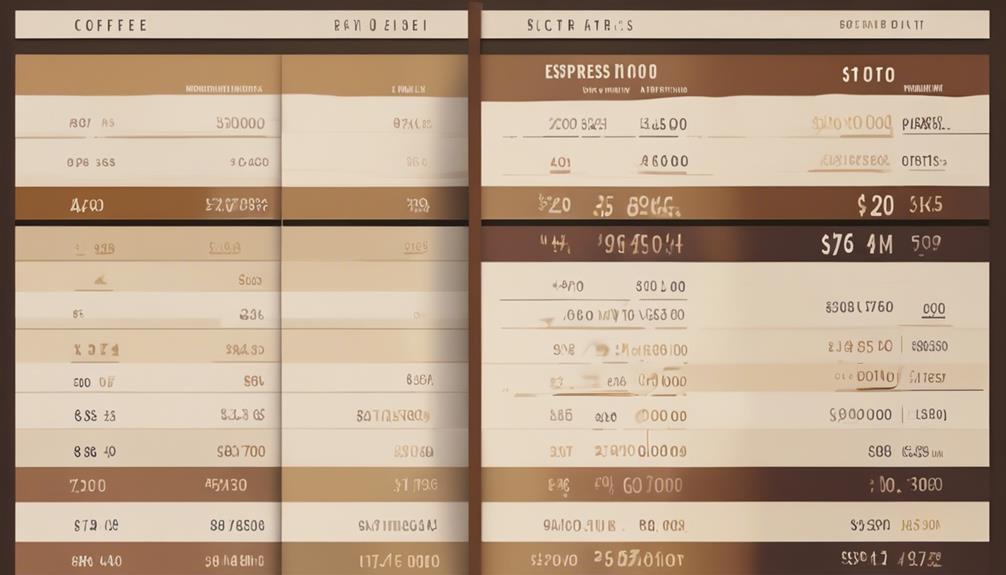
When analyzing competitors for pricing extra shots of espresso, it's essential to compare pricing strategies to set a competitive price point.
Consider market positioning strategies to determine whether to undercut or charge more than competitors.
Differentiation through pricing can help highlight the value of extra shots of espresso compared to others in the market.
Pricing Comparison Chart
Compare competitor pricing for extra shots of espresso to establish a clear understanding of market rates. Below is a pricing comparison chart outlining the average cost of an additional espresso shot among key competitors:
| Competitor | Price for Extra Shot of Espresso |
|---|---|
| Competitor A | $0.50 |
| Competitor B | $0.75 |
| Competitor C | $0.60 |
Analyzing competitor pricing allows you to set competitive rates while ensuring profitability. By using this data as a benchmark, you can develop a pricing strategy that aligns with market standards. Understanding how competitors price their extra espresso shots enables you to make informed decisions that cater to customer expectations and industry norms. By evaluating and adjusting your pricing based on this comparison, you can position your business effectively in the market.
Market Positioning Strategies
To effectively position your business in the market, analyze competitors' pricing for extra espresso shots to determine your competitive advantage. Conduct thorough competitor analysis to understand how they price their additional espresso shot and assess the perceived value customers associate with it.
By comparing these factors, you can strategically set competitive prices that attract customers while maximizing profitability. Consider the market positioning of your rivals and identify gaps where you can offer better value or appeal to a different segment of customers.
Utilize pricing strategies based on this competitor analysis to position your business effectively and stand out in the market. Adjust your pricing as needed to align with or differentiate from competitors, ensuring that you cater to customers seeking that much-desired extra shot of espresso.
Differentiation Through Pricing
To differentiate your pricing strategy and gain a competitive edge, analyze how competitors price their extra shots of espresso. By understanding competitor pricing, you can strategically position your own pricing to stand out in market.
Consider the following when analyzing competitor pricing:
- Offer a competitive price compared to rivals to attract price-sensitive customers.
- Determine the average cost of an extra shot of espresso at competing coffee shops for benchmarking purposes.
- Highlight any unique value or quality in your extra shot pricing to differentiate yourself in the market.
- Use competitor analysis to set a strategic price for extra shots of espresso that balances profit and competitiveness.
Average Latte Cost
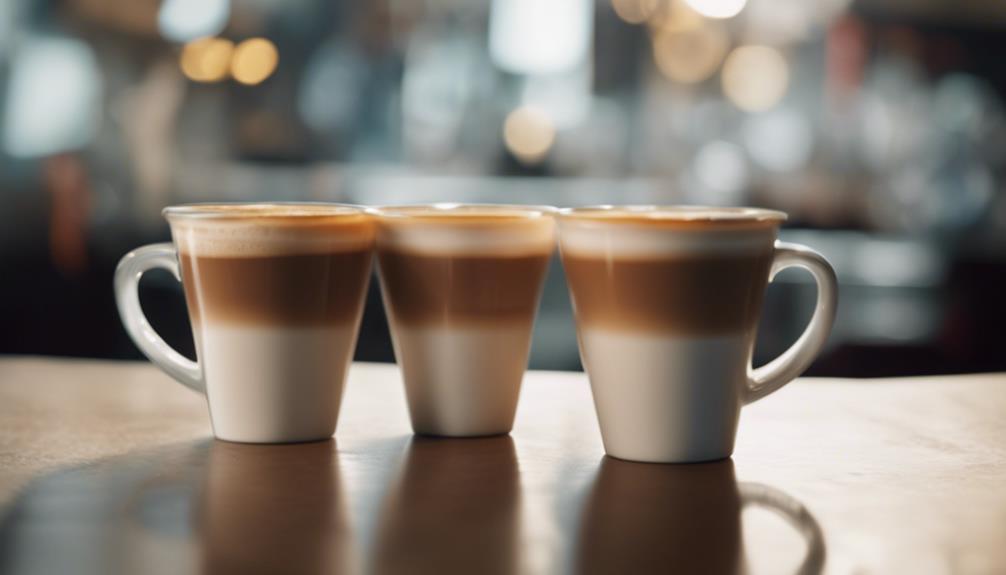
When considering the average cost of a latte, factors such as location, quality ingredients, and overhead expenses play a significant role in determining the final price. In the world of coffee shop businesses, the price of a latte typically falls around £2.75 on average. However, this cost can fluctuate based on various elements like the quality of coffee beans used, the type of milk, and any additional flavorings or syrups included in the drink.
Understanding the average cost of a latte involves delving into the intricacies of pricing strategies within the coffee industry. Businesses must carefully calculate the cost of goods, labor, and other overhead expenses to set a competitive yet profitable price for their lattes. Market research also plays an important role in determining the appropriate pricing in specific locations, ensuring that the cost aligns with consumer expectations and competitor offerings.
In essence, the average cost of a latte is a dynamic figure influenced by a combination of factors that coffee shop owners must carefully consider to maintain a successful business model.
Premium Pricing Strategies
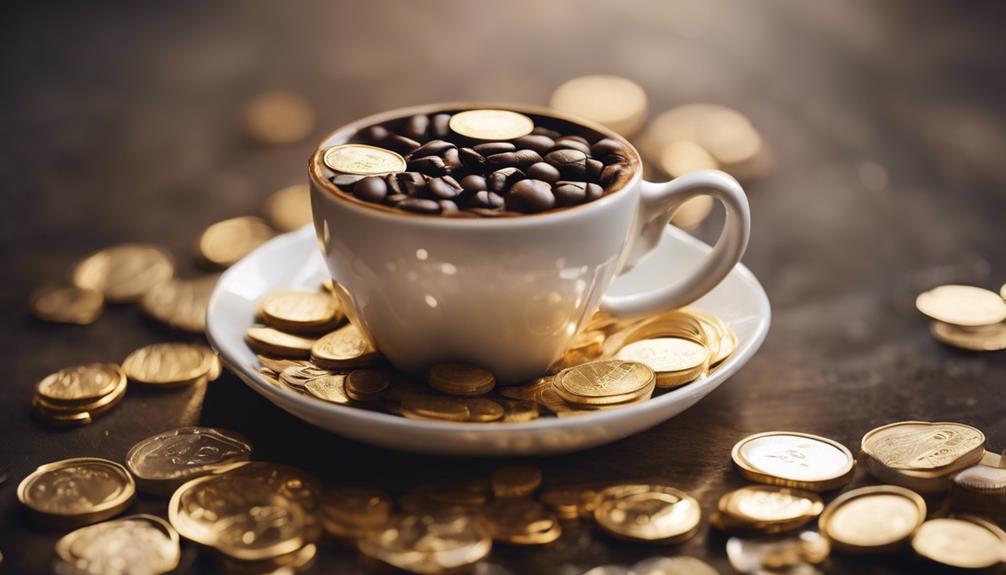
Premium pricing strategies for extra shots of espresso can greatly enhance both your coffee shop's profit margins and customer satisfaction. When implementing premium pricing for additional espresso shots, consider the following strategies:
- Enhanced Perceived Value: Setting higher prices for extra shots can make customers perceive the espresso as more valuable.
- Increased Profit Margins: Customers are often willing to pay more for premium espresso shots, leading to higher profits.
- Differentiation: Premium pricing can help differentiate your coffee shop from competitors by emphasizing quality.
- Customization and Quality: Capitalize on customer preferences for customization and quality by offering premium espresso shots.
Espresso Cost Calculator

Calculate the cost per espresso shot by starting with 18 grams of ground coffee.
Adjust the recipe to 16 grams to reduce the cost and determine the total espresso price accurately.
Use the Espresso Cost Calculator for precise pricing calculations to set a competitive selling price.
Cost per Espresso Shot
To determine the cost per espresso shot accurately, start by using 18 grams of ground coffee per double espresso. This initial step sets the foundation for calculating the pricing involved in each shot.
Here are some key points to keep in mind:
- Starting with 18 grams per double espresso guarantees consistency in your espresso quality and cost analysis.
- The cost per shot can be reduced by adjusting the recipe to 16 grams per double espresso, potentially saving on expenses.
- Understanding the breakdown of costs, such as a double espresso costing 24p per shot from a £13 1kg bag, is essential for your business plan.
- Knowing the potential selling price of a double espresso at £2.80 allows you to establish competitive pricing strategies and maximize profits effectively.
Total Espresso Price
When determining the total price of your espresso, incorporating an espresso cost calculator is essential for accurate cost analysis and profitability assessment. To calculate the total espresso price, start with 18 grams of ground coffee per double shot of espresso.
A 1kg bag of coffee costing £13 can produce a double espresso at a cost of 24p. By adjusting the recipe to 16 grams of coffee, the cost per double espresso can be reduced to 21p.
To guarantee profitability, consider selling a double shot of espresso at a price of £2.80. The espresso cost calculator plays a vital role in determining pricing strategies by taking into account the cost of coffee beans and desired profit margins.
Market Alignment
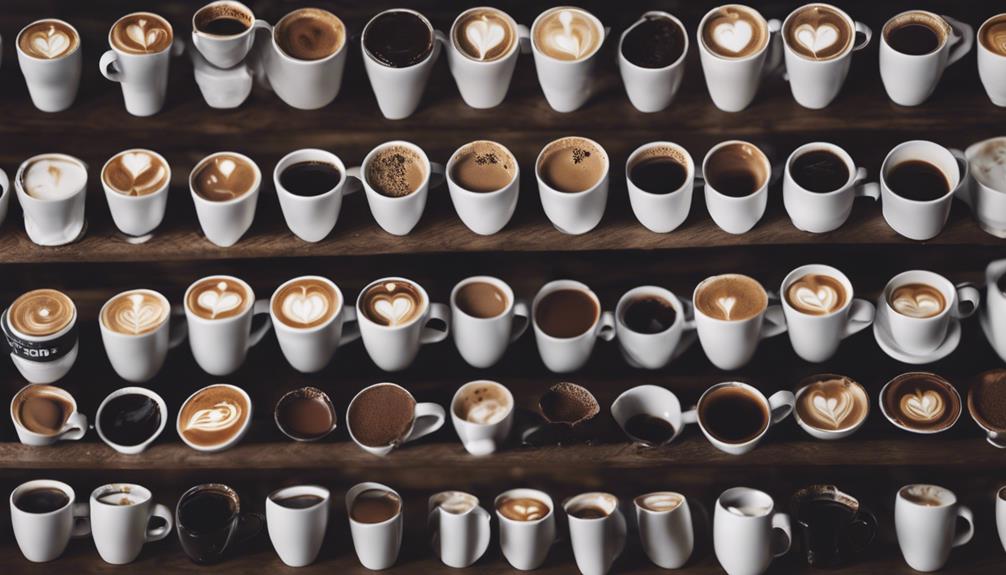
Make sure that your pricing for extra shots of espresso is in line with competitors' rates to maintain market alignment and competitiveness.
When setting the price for an additional espresso shot, consider the following:
- Analyze Local Coffee Shops: Study the pricing of extra espresso shots at nearby coffee establishments to confirm your rates are competitive.
- Consider Customer Perception: Take into account how customers perceive the value of an extra shot of espresso when determining the pricing to align with market expectations.
- Attract Price-Conscious Customers: Competitive pricing for extra shots can help draw in customers who are conscious of prices while still ensuring profitability.
- Research Pricing Strategies: Conduct market research on various pricing strategies for additional espresso shots to make informed decisions and stay competitive in the coffee industry.
Profit Optimization
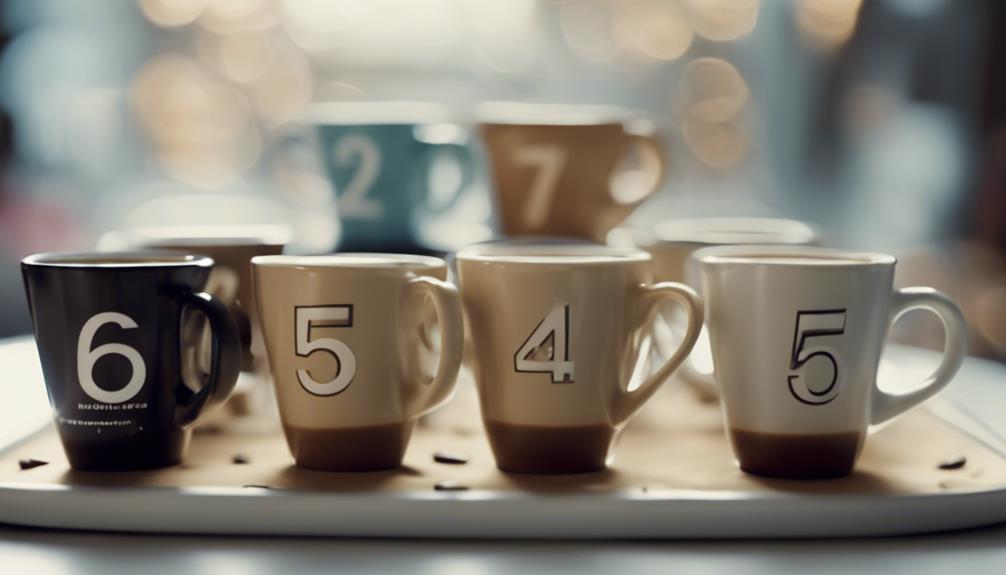
Calculating the cost of an extra shot of espresso is vital for optimizing profits and developing effective pricing strategies. To guarantee profit maximization, it's important to take into account factors such as labor costs, ingredient costs, and customer demand when determining the price for this offering.
By understanding the additional expenses associated with each extra shot of espresso, you can set competitive prices that not only cover your costs but also generate revenue. Analyzing customer demand and market trends for extra shots of espresso allows you to make pricing adjustments that align with consumer preferences, potentially boosting profitability.
Moreover, implementing cost-effective measures in the production and pricing of extra shots of espresso can lead to increased revenue and enhanced customer satisfaction. By carefully balancing these elements, you can optimize your profits while meeting the needs and expectations of your clientele.
Frequently Asked Questions
How Much Is an Extra Shot of Espresso at Starbucks?
An extra shot of espresso at Starbucks typically costs between $0.80 to $1.00. Prices may vary based on location and regional differences.
Adding an extra shot can boost caffeine levels and the drink's intensity. Some specialty espresso drinks already include multiple shots.
When customizing your order, remember to factor in the additional cost for an extra shot of espresso.
How Much Money Is a Double Shot of Espresso?
A double shot of espresso typically costs between $2.50 to $3.50 at most coffee shops. Prices may vary depending on the quality of espresso beans, the location of the coffee shop, and whether it's a specialty or chain establishment. Discounts or promotions for multiple shots may also be available.
Factors like serving size and ambiance can influence the pricing. Be prepared to pay a bit more at fancier spots for your caffeine fix!
How Much Should a Double Espresso Cost?
A double espresso's cost varies based on factors like ingredient quality and quantity. Standardly, it's around 24p to make, considering coffee beans and other costs. Adjusting the recipe can cut costs and boost profits.
Pricing a double espresso at roughly £2.80 can be competitive and profitable for coffee shops. Calculating costs per double espresso from a 1kg bag can guide pricing decisions for coffee businesses.
Can I Ask for an Extra Shot of Espresso?
Yes, you can typically ask for an extra shot of espresso in your coffee order at most coffee shops. Adding an extra shot may result in a stronger flavor and more caffeine.
Some places might charge extra for this, so be ready for a potential price increase. The cost of an extra shot can vary depending on the coffee shop.
It's a simple way to customize and enhance your coffee experience.
Conclusion
To sum up, it's noteworthy that the average cost of an extra shot of espresso in a latte varies from $0.50 to $1.00, depending on various pricing factors.
A recent market study revealed that implementing premium pricing strategies for espresso could boost overall profits by up to 15%.
By carefully aligning pricing with market demands and optimizing profit margins, coffee shops can effectively capitalize on the popularity of additional espresso shots in their beverages.



